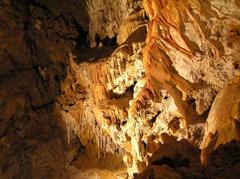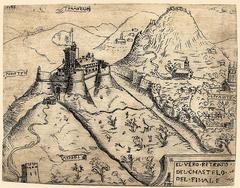Ponte Sordo Visiting Hours, Tickets & Detailed Guide to Finale Ligure Historical Sites
Date: 14/06/2025
Introduction
Nestled in the picturesque Val Ponci near Finale Ligure, Ponte Sordo is a striking testament to Roman engineering and history. This ancient bridge, a key remnant of the Via Julia Augusta, once connected northern Italy with southern Gaul and played a vital role in military, commercial, and administrative networks. Today, its evocative ruins offer visitors a window into the past, while the surrounding valley presents a rich mix of archaeological, natural, and cultural attractions. This guide delivers everything you need to plan a memorable visit, from historical context and architectural insights to practical tips, accessibility details, and suggestions for exploring Finale Ligure’s broader heritage.
Table of Contents
- Introduction
- Roman Origins and the Via Julia Augusta
- Architectural Features and Construction
- Historical and Cultural Significance
- Etymology and Local Lore
- Archaeological Context and Preservation
- The Bridge Through the Ages
- Visiting Ponte Sordo: Practical Information
- Environmental and Cultural Etiquette
- Visitor Experience: Tips and Safety
- Visuals and Interactive Media
- Frequently Asked Questions (FAQ)
- Conclusion & Key Visitor Tips
- References and Further Reading
Roman Origins and the Via Julia Augusta
Ponte Sordo, also referred to as Ponte Mollo, is one of five surviving Roman bridges in Val Ponci. Constructed circa 13–12 BCE during the reign of Emperor Augustus, the bridge formed part of the Via Julia Augusta—a strategic inland Roman road linking Placentia (modern Piacenza) with Arelate (now Arles, France) (turismo.comunefinaleligure.it). This inland route was chosen to avoid the dangerous cliffs along Capo Noli, highlighting Roman ingenuity in road planning and adaptation to challenging terrain.
The Via Julia Augusta facilitated the movement of troops, goods, and information, integrating this coastal region into the wider Roman world and enabling efficient administration and economic development (hikingfinaleligure.jimdofree.com).
Architectural Features and Construction
Situated as the second bridge along the Val Ponci stretch of the Via Julia Augusta, Ponte Sordo was built from local Pietra di Finale limestone. Its original single-arch design, with a roadway over four meters wide, exemplifies the gallo-ligure architectural style—characterized by a single span with double rings of wedge-shaped stones (voussoirs) (mudifinale.com). This robust design allowed the bridge to withstand periodic floods and the test of time.
Today, visitors can observe substantial remnants of the monumental ramp and abutments, revealing the scale and craftsmanship of Roman construction. While the original arch has disappeared, the surviving stonework provides insight into ancient engineering methods.
Historical and Cultural Significance
Ponte Sordo and its neighboring bridges underscore Finale Ligure’s strategic role as a conduit between Liguria and southern France. Their construction enabled safe, year-round passage through difficult terrain and supported trade, military operations, and cultural exchange across the Roman Empire (visitfinaleligure.it).
The bridges and road remain emblematic of Roman influence, shaping settlement patterns and facilitating centuries of economic growth and regional integration (passeggiareinliguria.it).
Etymology and Local Lore
The name “Ponte Sordo” (literally, “Deaf Bridge”) is shrouded in local legends and ambiguity. Other bridges in Val Ponci, such as Ponte delle Fate (“Fairies’ Bridge”) and Ponte Muto (“Mute Bridge”), also bear evocative names that hint at folkloric stories, possible acoustic phenomena, or simply the imagination of generations past (passeggiareinliguria.it). These names add a layer of mystique, enriching the visitor experience.
Archaeological Context and Preservation
Val Ponci is home not only to Roman bridges but also ancient quarries—“cave romane”—that supplied the durable Pietra di Finale for these monumental works (mudifinale.com). The valley’s prehistoric caves, such as Arma delle Manie, have yielded Neanderthal artifacts, now exhibited at the Museo Archeologico del Finale.
Ponte Sordo and its fellow bridges are protected cultural heritage sites under ongoing conservation efforts led by local authorities and the Museo Archeologico del Finale (visitfinaleligure.it). Stabilization of masonry and erosion control are key aspects of preservation, ensuring these ancient monuments endure for future generations.
The Bridge Through the Ages
While Ponte Sordo’s origins are Roman, its functional relevance continued through the Middle Ages and into modern times. The ancient corridor remained vital for local trade and travel, further embedding the bridge into the region’s economic and social fabric (turismo.comunefinaleligure.it).
Visiting Ponte Sordo: Practical Information
Visiting Hours and Tickets
- Open-Air Site: Ponte Sordo is freely accessible year-round during daylight hours. There is no entrance fee or ticket required to visit the site (visitfinaleligure.it).
Accessibility and Directions
- Trail Access: The bridge is best reached by hiking or mountain biking along well-marked trails beginning in Finale Ligure or from the hamlet of Calvisio. The route from Calvisio Vecchia to Ponte Sordo is approximately 2.5 km and suitable for most fitness levels (finaleoutdoor.com).
- Public Transport: Regional trains and buses serve Finale Ligure, with local buses reaching Calvisio. Parking at trailheads is available but limited during peak seasons.
Guided Tours and Events
- Archeotrekking: The Museo Archeologico del Finale offers expert-led “Archeotrekking” tours that provide in-depth historical and archaeological interpretation (museoarcheofinale.it). Advance booking is recommended, especially during high season.
- Events: Seasonal events and historical reenactments may be offered—check with local tourism offices for current schedules.
Nearby Attractions and Amenities
- Roman Bridges: Val Ponci features four other Roman bridges, each with distinct architectural features.
- Museo Archeologico del Finale: Located in Finalborgo, it houses artifacts from the region’s prehistoric and Roman past (museoarcheofinale.it).
- Finalborgo and Forte San Giovanni: Explore the medieval village and fortress for immersive cultural experiences (Italia.it).
- Beaches and Outdoor Activities: Enjoy Finale Ligure’s Blue Flag beaches, rock climbing, and mountain biking (finaleoutdoor.com).
Environmental and Cultural Etiquette
- Archaeological Respect: Do not climb on, damage, or remove stones from the ruins.
- Nature Protection: Carry out all litter, keep noise to a minimum, and avoid lighting fires, especially during dry periods (finaleoutdoor.com).
- Wildlife and Plantlife: Respect local flora and fauna; dogs are welcome on leash.
- Sustainability: Support conservation by using marked trails and considering donations or trail-support cards.
Visitor Experience: Tips and Safety
- Best Time to Visit: Late spring to early autumn (May–October) for mild weather and optimal trail conditions. Avoid hiking during heavy rains or weather alerts (Allerta Liguria).
- What to Bring: Sturdy walking shoes, water, snacks, layers for changing weather, and a map or GPS device.
- Accessibility: Trails are not suitable for wheelchairs or strollers; families with older children will find them manageable.
- Safety: Inform someone of your route, check weather updates, and keep emergency numbers handy (112 for emergencies, 1515 for forest fires).
Visuals and Interactive Media
For a richer experience, consult virtual tours, interactive maps, and high-quality images of Ponte Sordo and Val Ponci available on Visit Finale Ligure and Finale Outdoor Region. Use descriptive alt tags such as “Ruins of Ponte Sordo Roman bridge in Val Ponci” for accessibility and search optimization.
Frequently Asked Questions (FAQ)
Q: What are the visiting hours for Ponte Sordo?
A: Ponte Sordo is open-air and accessible year-round during daylight hours without restrictions.
Q: Is there an entrance fee or ticket required?
A: No, the site is free to visit.
Q: How do I reach Ponte Sordo?
A: Hike or bike from Finale Ligure or Calvisio; trailheads are clearly marked and maps are available at local tourist offices.
Q: Are guided tours available?
A: Yes, the Museo Archeologico del Finale offers guided tours; advance booking is recommended.
Q: Is the site wheelchair accessible?
A: No, natural terrain and unpaved paths may be challenging for those with mobility issues.
Q: What should I bring?
A: Sturdy shoes, water, snacks, layered clothing, and a map or GPS.
Conclusion & Key Visitor Tips
Ponte Sordo is a remarkable testament to Roman engineering and the enduring legacy of the Via Julia Augusta. Whether you’re passionate about archaeology, architecture, or outdoor adventure, this unique site and its surroundings offer a wealth of experiences. Plan your visit during favorable seasons, take advantage of guided tours for deeper insight, and explore the broader Finale Ligure region for a well-rounded adventure. By respecting both the archaeological remains and the natural landscape, you contribute to the preservation of this invaluable heritage for future generations.
For up-to-date information, trail maps, and cultural recommendations, download the Audiala app and follow local tourism resources.
References and Further Reading
- Ponte Sordo: Roman Bridge History, Tickets, and Travel Tips in Finale Ligure, 2025 (turismo.comunefinaleligure.it)
- Ponte Sordo: Visiting Hours, Tickets, and Exploring Finale Ligure’s Historic Roman Bridge, 2025 (hikingfinaleligure.jimdofree.com)
- Ponte Sordo Visiting Hours, Tickets & Guide to Finale Ligure Historical Sites, 2025 (mudifinale.com)
- Ponte Sordo Visiting Hours, Tickets, and Guide to Finale Ligure Historical Sites, 2025 (visitfinaleligure.it)
- Finale Outdoor Region Trails and Information, 2025 (finaleoutdoor.com)

